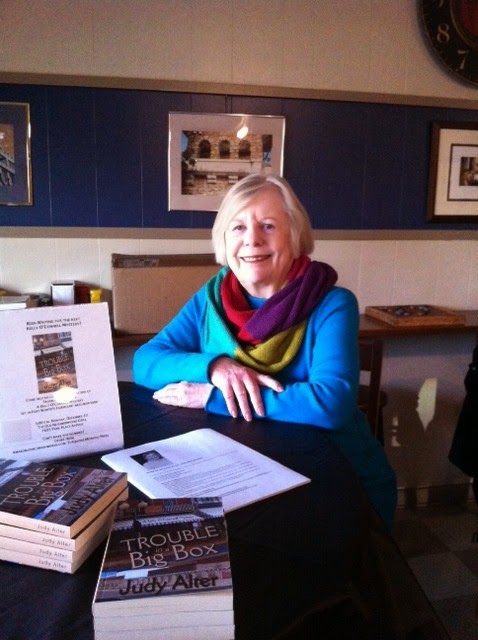by Judy Alter
Color me excited as I reveal the cover of my
forthcoming novel, The Perfect Coed. My
first venture into self-publishing will launch October 15.
Years ago—maybe ten?—I knew I wanted to write
mysteries. One mystery, I told myself, and I’d be happy. So I wrote a novel I
called The Perfect Coed. At the time
I didn’t belong to Sisters in Crime, knew nothing about the world of mystery
publishing, and even less about self-publishing, which back then still hadn’t
quite lost its stigma. An agent tried to sell it, although she wanted me to
turn it into a romance, and I balked.
Time intervened, but one day I told myself I
read a lot of mysteries, some of them good, some of them not so good. If others
could do it, so could I. So I wrote the first of my Kelly O’Connell
Mysteries…and suffered all the first-book agonies: rejection by editors, a
year-long wait while a small press “winnowed its list” (I’ll never do that
again), and another year wasted with an agent who sent a contract and then
rapidly lost interest, although he showed it to all six major NY publishers,
thereby making it dead in the water for most agents. I am eternally grateful to
Turquoise Morning Press for accepting Skeleton
in a Dead Space, publishing it quickly,
and going on to publish five more Kelly O’Connell Mysteries and two in
the Blue Plate Café series.
But times, presses, and authors
change—Turquoise Morning turned more and more toward romance, I grew impatient
on several fronts and wanted to try self-publishing. So I went back to The Perfect Coed, rewrote, rewrote
again, finally sent it to readers, and then sent it for editing.
I followed all the steps of
self-publishers—hire an editor, a designer, a formatter, and begin a marketing
plan. Thanks to all the people who helped me along the way—Mary Dulle, Lourdes
Venard, Lynn Stanzione, Jenn Zacek.
Now I’ve begun marketing efforts, even though
the book doesn’t come out in October. But I’m as excited as a small kid waiting
for Christmas. Watch for it, wait for it, and I hope you’ll read it. Here’s a
blurb to pique your interest:
Susan Hogan is smart, pretty—and prickly. There was no other word for it. She is prickly with Jake Phillips and her Aunt Jenny, the two people who love her most in the world. And she is prickly and impatient with some of her academic colleagues and the petty jealousies in the English department at Oak Grove University. When a coed’s body is found in her car and she is suspected of murder, Susan gets even more defensive.
But when someone begins to stalk and threaten her—trying to run her down, killing the plants on her deck, causing a moped wreck that breaks her ankle—prickly mixes with fear. Susan decides she has to find the killer to save her reputation—and her life. What she suspects she’s found on a quiet campus in Texas is so bizarre Jake doesn’t believe her. Until she’s almost killed.
The death of one coed unravels a tale of greed, lust, and obsession.
 |
| Sophie partied a little too hard! |
You can help by spreading the word, reading it, and posting reviews on Amazon and Goodreads, and I’ll be eternally grateful to you. The world of self-publishing is a big and scary one to jump into, but I’m taking the leap, and I’m excited about it.
****
Judy Alter is the author of five Kelly
O’Connell novels—Skeleton in a Dead
Space, No Neighborhood for Old Women, Trouble in a Big Box, Danger Comes Home, and
Deception in Strange Places (which
will launch July 31) as well as two in the Blue Plate Café Series, Murder at the Blue Plate Café and Murder at the Tremont House.
Earlier in her career she wrote a series of
fictional biographies of women of the American West: Libbie (Elizabeth Bacon Custer), Sundance, Butch and Me (Etta Place, the Sundance Kid’s girlfriend
and the Hole in the Wall Gang), Cherokee
Rose (based on the life of cowgirl Lucille Mulhall), and Mattie (based on the life of pioneer
woman physician Georgia Arbuckle Fix). And she has written many books, fiction
and nonfiction, for young readers
Judy is retired as director of Texas
Christian University Press and is the single parent of four grown children and
the grandparent of seven. She lives in Fort Worth, Texas with her biggest fan,
Sophie, her Border Collie x Poodle cross.


































